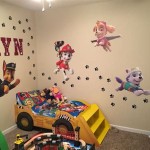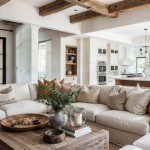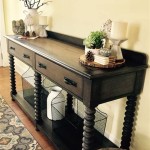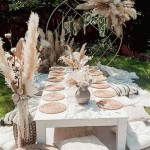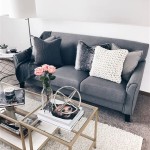```html
Decorating Ideas for Room Enhancement
Room decoration plays a pivotal role in shaping the ambiance and functionality of a living space. Thoughtfully chosen decor elements can transform a mundane room into a haven of comfort, style, and personal expression. Successful room decoration requires careful consideration of several factors, including the room's purpose, size, natural light, and the preferences of the occupants. This article explores a range of decorating ideas to enhance rooms across various styles and purposes.
Color Palette Selection
Color is a fundamental element of room decoration. It significantly impacts the mood and perception of space. The selection of a suitable color palette is, therefore, a crucial initial step. Light and neutral colors, such as off-white, beige, and light gray, are known to make rooms appear larger and brighter. These colors reflect light effectively, creating an airy and open feel. They also provide a versatile backdrop for incorporating bolder accent colors through furniture, artwork, and accessories.
Darker colors, such as navy blue, deep green, and charcoal gray, can add depth and sophistication to a room. However, it is essential to use them judiciously, particularly in smaller spaces, to avoid making the room feel cramped. Darker colors work well as accent walls or in rooms with ample natural light. Consider the existing architectural features and natural light when choosing a color palette. Rooms with southern exposure receive warm light, which complements cooler color schemes, while rooms with northern exposure benefit from warmer tones to counteract the cooler light.
Monochromatic color schemes involve using different shades of a single color. This approach creates a cohesive and calming effect. Complementary color schemes involve using colors that are opposite each other on the color wheel, such as blue and orange or red and green. This creates a vibrant and energetic feel. Analogous color schemes involve using colors that are adjacent to each other on the color wheel, such as blue, blue-green, and green. This creates a harmonious and balanced effect.
Furniture Arrangement and Placement
The arrangement of furniture is critical to the functionality and flow of a room. A well-arranged room should facilitate easy movement and interaction while maximizing the available space. Start by identifying the focal point of the room, which could be a fireplace, a large window, or a prominent piece of artwork. Arrange furniture to draw attention to this focal point.
In living rooms, the seating area should be conducive to conversation. Arrange sofas and chairs in a way that encourages interaction. Consider using a coffee table or ottoman to anchor the seating area and provide a surface for drinks and snacks. Ensure that there is ample space between furniture pieces to allow for comfortable movement. Avoid overcrowding the room with too much furniture, as this can make it feel cramped and cluttered.
In bedrooms, the bed is typically the focal point. Position the bed against the longest wall to create a sense of stability. Nightstands should be placed on either side of the bed for convenience. If space allows, a dresser or chest of drawers can be placed against another wall for storage. Consider adding a comfortable armchair or chaise lounge to create a cozy reading nook.
In dining rooms, the dining table should be the centerpiece of the room. Ensure that there is enough space around the table for chairs to be pulled out comfortably. A sideboard or buffet can be placed against a wall for storage and serving purposes. Consider adding a rug under the dining table to define the space and add warmth.
Lighting Design and Fixture Selection
Lighting plays a crucial role in setting the mood and enhancing the functionality of a room. A well-designed lighting scheme should incorporate a variety of light sources, including ambient lighting, task lighting, and accent lighting. Ambient lighting provides overall illumination to the room. This can be achieved through ceiling fixtures, such as chandeliers, pendant lights, or recessed lighting.
Task lighting provides focused illumination for specific activities, such as reading, cooking, or working. This can be achieved through table lamps, floor lamps, or under-cabinet lighting. Accent lighting is used to highlight specific features of the room, such as artwork, architectural details, or decorative objects. This can be achieved through spotlights, track lighting, or wall sconces.
When selecting light fixtures, consider the style of the room and the desired ambiance. Chandeliers can add elegance and grandeur to a dining room or living room. Pendant lights can add a modern touch to a kitchen or bedroom. Table lamps and floor lamps can provide warm and inviting light to a living room or bedroom. Wall sconces can add a touch of sophistication to a hallway or bathroom.
The color temperature of light bulbs also impacts the mood of a room. Warmer light colors (2700-3000K) create a cozy and inviting atmosphere, while cooler light colors (3500-4000K) create a brighter and more energetic atmosphere. Consider using dimmer switches to adjust the intensity of the lighting and create different moods.
Wall Decor and Artwork
Wall decor and artwork can add personality and visual interest to a room. Consider incorporating a variety of elements, such as paintings, prints, photographs, mirrors, and wall sculptures. When selecting artwork, consider the style of the room, the color palette, and the size of the wall. Large pieces of artwork can make a statement and serve as a focal point, while smaller pieces can be grouped together to create a gallery wall.
Mirrors can be used to create the illusion of more space and reflect light. Position mirrors strategically to maximize their impact. For example, placing a large mirror across from a window can make a room feel larger and brighter. Hanging a mirror above a fireplace can create a focal point and add visual interest.
Wall sculptures can add texture and dimension to a room. Consider using metal sculptures, wooden carvings, or ceramic tiles. These elements can add a unique and artistic touch to the room. Wall decor can significantly contribute to the overall aesthetic of a room.
Textiles and Soft Furnishings
Textiles and soft furnishings, such as rugs, curtains, cushions, and throws, add comfort, warmth, and texture to a room. When selecting textiles, consider the style of the room, the color palette, and the function of the space. Rugs can define different areas of the room and add warmth underfoot. Choose a rug that is appropriately sized for the space and complements the furniture.
Curtains can provide privacy, block out light, and add visual interest. Consider the length, width, and fabric of the curtains. Long, flowing curtains can add elegance and drama to a room, while shorter curtains can create a more casual feel. Cushions and throws can add pops of color, texture, and comfort to sofas, chairs, and beds. Choose cushions and throws in a variety of textures and patterns to create visual interest.
The type of fabric also matters. Natural fibers, such as cotton, linen, and wool, are breathable and durable. Synthetic fibers, such as polyester and acrylic, are more resistant to stains and fading. Choose fabrics that are appropriate for the wear and tear that they will be subjected to.
Accessorizing and Personal Touches
Accessories and personal touches are essential for creating a room that reflects the occupants' personality and style. Consider incorporating items that are meaningful and visually appealing, such as books, plants, candles, and decorative objects. Books can add character and intellectual appeal to a room. Display books on shelves, coffee tables, or side tables.
Plants can add life and freshness to a room. Choose plants that are appropriate for the amount of light and humidity in the room. Candles can create a warm and inviting atmosphere. Choose candles in a variety of scents and sizes. Decorative objects, such as vases, sculptures, and bowls, can add visual interest and personality to a room.
Personal touches, such as family photos, travel souvenirs, and handcrafted items, can make a room feel more personal and inviting. Display these items in a way that is visually appealing and meaningful to the occupants. The key to successful accessorizing is to avoid clutter. Choose a few carefully selected items that complement the overall style of the room.
Ultimately, successful room decoration involves a holistic approach that considers color, furniture arrangement, lighting, wall decor, textiles, and accessories. By carefully planning and executing these elements, it is possible to transform any room into a space that is both functional and aesthetically pleasing.
```
10 Best Bedroom Accent Wall Decor Ideas Modern Interior Design Home Décor Inspiration Decoholic

Ways To Decorate Your Uni Room As A Student Decor Ideas College Dorm Design

Kids Room Decorating Ideas That Go From Toddler To Teen

Diy Dorm Decor Ideas By Phil Collins From Essayservice

Cottagecore Bedroom Decorating Ideas Tour 2025 Thrifty And Chic

80 Gorgeous Living Room Decorating Ideas For Every Style

14 Budget Friendly Bedroom Decor Ideas Society6

7 Simple Summer Bedroom Decorating Ideas Setting For Four Interiors

Dorm Room Ideas And Inspiration How To Create A Cozy College Space With Style Jane At Home

120 Absolute Stunning Boho Bedroom Design Ideas On You Shouldn T Miss This Year Page 5 Of 6
